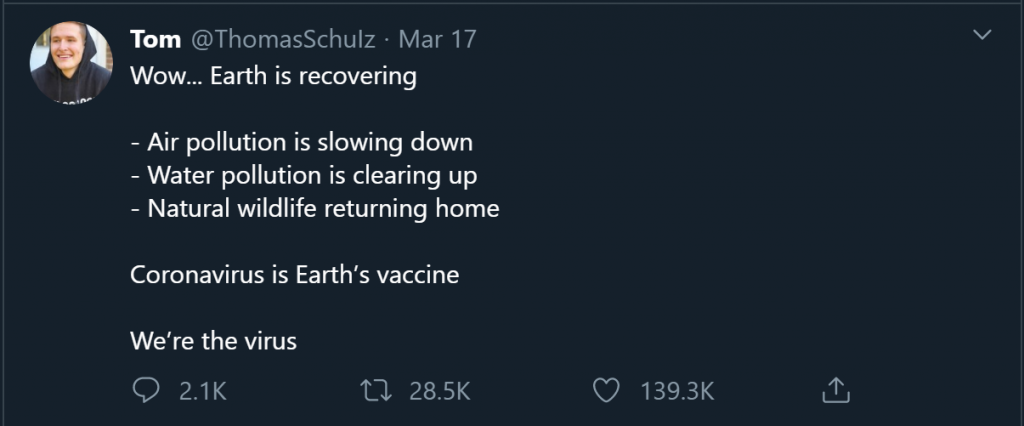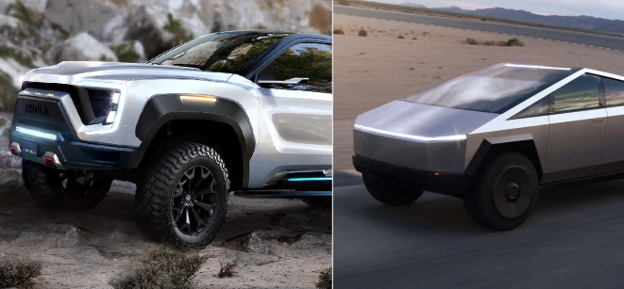Good Morning Everyone 👐
New York City is basically a ghost town, toilet paper is now a currency and pollution levels across the world have finally dropped. Welcome to 2020 where you are forced to find a silver lining in everything. Fortunately this week has some awesome updates from the sustainability & clean tech world. But before that – here is some dark humor to lighten up your day – heh

In your inbox: Nikola Motor Co and their Hydrogen Powered Trucks and the even more massive assortment of solar panel selections for your home; Emissions are down since the winter 2019; and how the way utilities handle solar deployments can cause the slowing of solar adoption
In The Green Room – Check out our tips for how you can reduce your carbon footprint and maybe save a few bucks as you transition into a remote lifestyle…at least for a few weeks.
Startups & Technology
Solar Is Beautiful In All Shapes & Sizes
It’s no surprise that if you can – installing solar on your roof can provide one of the biggest benefits from a carbon footprint reduction standpoint. Even with this temporary slow down in the market right now major manufacturers have still pushed the boundaries of what value we can get out of these residential spec’d solar panels. Jinko Solar announced their new residential line of panels that can push up to 16% more power than traditional panels, while crossing the 400W mark. Joining the likes of Sunpower, LG & Solaria in the 400 W club proves progress is accelerating.
But you are not just some average consumer that buys tech for “tech sake”…that’s our job! With more of these panels reaching similar performance it can be hard to tell what makes them different and it really just comes down to price & inches, literally. Sunpower has made performance improvements by increasing the size of their panels, LG is just a quality branded & produced all rounder, Solaria is the small kid on the block with the coolest tech for shading and now we have Jinko – who from their announcement specs seem like they are a mix of cheap but LG performance panels. Which we will have to see once we find a few in the field – unlike the 2 Tesla Solar Roof installations PV Mag found in the field…falling short of the 1000/week even before the current market situation.
So what does that mean for you if you are just entering into the market for solar.
The simple answer is it depends on your specific situation, so here is a quick overview of what the street tells us the advantages are:
️ Electric Vehicles or Hydrogen Electric Vehicles???
You may not have heard about Nikola Motor Company since 2016 when they announced their hydrogen Nikola One truck or 2018 when they sued Tesla over their Semi. They’re taking a different approach and embracing not only being a motor company, but also an energy company. They haven’t delivered a truck yet, just went public but are valued well over a Billion and they expect to launch its battery-electric truck for the urban market later next year following with their long-haul hydrogen fuel-cell trucks and want the industry to know that they are here to last. How they plan to do that is interesting and can be really impactful from a decarbonization of the trucking industry standpoint. To quote CEO Trevor Milton – they are more interested in building and owning hydrogen refueling stations across the US & Europe than selling the most HEV trucks.
Which gets us thinking…do we go and get a Cybertruck or a Nikola Badger and which one will be better???

From a spec’s standpoint the Nikola Badger has claimed a whopping 600 Miles on a full tank + battery and has gotten one of our editors a little bit too excited about turning in their old Tacoma…
At the same time the cybertruck is proving to be one of the most hyped up upcoming vehicles, but, our hunch is that you won’t see it for at least 3 years on the road.
But we can’t just leave all the fun to Nikola & Tesla 😏
The HEV space by itself is heating up and we have a hunch it is truly the future for vehicles that require a massive amount of energy & power for a long period of time. Trucks, Airplanes, Cruise ships and other “big rig” type vehicles will likely convert to HEV over the next decade but it is going to be dependent on the amount of refueling stations & production capacity we can bring to the market to enable such a world. Going full Electric or Hydrogen Electric promises a global transportation network being entirely decarbonized…
As prices drop & the tools become more commodity I am sure we will see more and more people being able to make the move to cleaner and honestly a higher performance vehicle option.
It starts with more manufacturers and companies entering the market. Like Hyzon Motors – which is claiming the title to become the first US manufacturer to produce PEM fuel cells. Introducing Busses and Trucks in late 2020, and expanding to Vans and other vehicles in 2021.They’re offering operating leases for commercial customers (they have 2,000 heavy vehicle deployments planned over the next three years), and are arranging partners for fueling stations – maybe we will see a collaboration between Hyzon & Nikola in the coming years.
🧬 Science
You’ve seen the memes (even we couldn’t help ourselves at the top of this email): as industries slow, people fly less, and emissions fall. There’s truth that lower economic activity can mean lower emissions (especially when people aren’t allowed out of their house to commute an hour to work), but unless we get serious about actually restructuring our society to be more sustainable, history shows emissions will bounce right back – check out the Great Depression in the 1930s and the end of World War II in 1945:
So worth considering if you can keep working from home after this Pandemic passes, and other ways you can lower your emissions.
If you’ve been on social media these last few weeks you’ve probably seen the fun, lighthearted stories about the return of nature to our cities in the sudden absence of human activity. Posts about swans and dolphins returning to the suddenly crystal clear waters of Venice, or elephants stealing corn wine and getting drunk while the humans were out social distancing have both been debunked as either completely fabricated for the likes (Venice Dolphins), or are already part of day-to-day life and nothing out of the ordinary (although elephants stealing corn and getting drunk is still funny).
What is real news is that 2019 saw the biggest fall of global carbon dioxide (CO2) emissions from the power sector at 2%! Thanks to reduced coal usage in Europe (down 24% with a drive towards renewables 🙌🏼) and the U.S. (down 16% because natural gas became cheaper 🤦🏼). Oh– and China’s output rose so they’re now responsible for half of the global coal-fired power generation. Here’s the thing: the world needs to drop coal usage by 11% every year to keep within a warming limit of 1.5 degrees Celsius, and natural gas may not be as dirty of a fuel as coal, but it’s nowhere near carbon neutral. [The Guardian]
Policy & Finance
We got some good news and some bad news for you today. We’re going to end with the good because we want to end the news on a happy note!
THE BAD:
Massachusetts solar had a rough year. In 2019, new installations fell 50% and the sector’s workforce shrank by 30% – and not from lack of interest! Projects and installations (even some in mid-construction) are stuck in utility-caused bureaucratic red tape, and rural NIMBYism. The state’s Department of Energy Resources saw 2,500 applications for solar installations in the first week they opened their applications, but two weeks in Massachusetts utility provider National Grid launched a “cluster study,” to look at projects over 1 MW to determine how they might impact the transmission grid. In the process, 900 MW of solar installations were stalled and are still “awaiting the results of further studies.”
THE GOOD:
NY Governor Cuomo used his 2020 State of the State Address to announce 21 Large-Scale Renewable Energy Projects that will generate enough renewable energy to power over 350,000 New York homes – a big step for the Governor’s Green New Deal goal to source 70% of the state’s electricity from renewables by 2030.
The Green Room
This isn’t the newsletter for pandemic news (we recommend The CDC website for that) but this is the place to talk about how you can make the best of #stayathomechallenge and reduce your carbon footprint without getting cabin fever.
So while at home give one of these 3 things a shot:
With all that being said avoid driving your car, keep your thermostat in check and take some time to take inventory of your home so once this pandemic ends…you can get back to making your home more resilient, efficient and carbon neutral.
As a closing thought :: To everyone who might be in a tough situation right now, we feel you and are here to provide some light to your day through this newsletter. Hang in there, stay calm – it will get better. We believe in you.
Podcast | Big Feet
This week on BigFeet… Our friend Victoria Beall (@environmentoria) comes on the show and to talk about how I can start living a more sustainable life now. Check out her list of low and zero waste alternatives to the single use products in our lives everyday. It doesn’t cover everything, but we found it’s a great way to take stock of how much plastic is really in your life.
Develop your market map of up-and-coming climate startups and market opportunities by subscribing to our weekly newsletter for free.